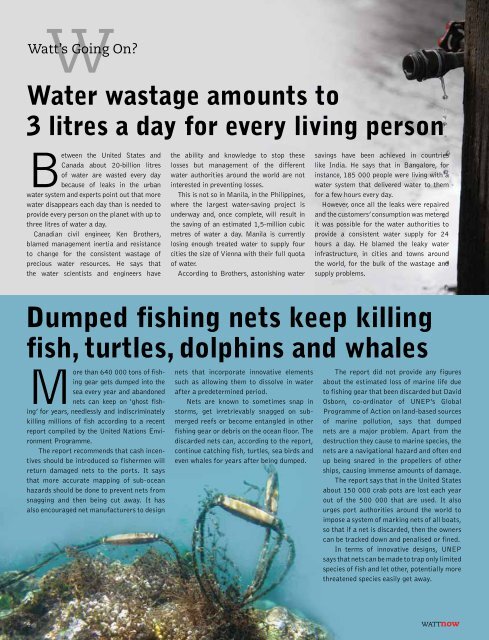W<strong>Watt</strong>’s Going On?Water wastage amounts to3 litres a day for every living personBetween <strong>the</strong> United States andCanada about 20-billion litres<strong>of</strong> water are wasted every daybecause <strong>of</strong> leaks in <strong>the</strong> urbanwater system and experts point out that morewater disappears each day than is needed toprovide every person on <strong>the</strong> planet with up tothree litres <strong>of</strong> water a day.Canadian civil engineer, Ken Bro<strong>the</strong>rs,blamed management inertia and resistanceto change for <strong>the</strong> consistent wastage <strong>of</strong>precious water resources. He says that<strong>the</strong> water scientists and engineers have<strong>the</strong> ability and knowledge to stop <strong>the</strong>selosses but management <strong>of</strong> <strong>the</strong> differentwater authorities around <strong>the</strong> world are notinterested in preventing losses.This is not so in Manila, in <strong>the</strong> Philippines,where <strong>the</strong> largest water-saving project isunderway and, once complete, will result in<strong>the</strong> saving <strong>of</strong> an estimated 1,5-million cubicmetres <strong>of</strong> water a day. Manila is currentlylosing enough treated water to supply fourcities <strong>the</strong> size <strong>of</strong> Vienna with <strong>the</strong>ir <strong>full</strong> quota<strong>of</strong> water.According to Bro<strong>the</strong>rs, astonishing watersavings have been achieved in countrieslike India. He says that in Bangalore, forinstance, 185 000 people were living with awater system that delivered water to <strong>the</strong>mfor a few hours every day.However, once all <strong>the</strong> leaks were repairedand <strong>the</strong> customers’ consumption was meteredit was possible for <strong>the</strong> water authorities toprovide a consistent water supply for 24hours a day. He blamed <strong>the</strong> leaky waterinfrastructure, in cities and towns around<strong>the</strong> world, for <strong>the</strong> bulk <strong>of</strong> <strong>the</strong> wastage andsupply problems.Dumped fishing nets keep killingfish, turtles, dolphins and whalesMore than 640 000 tons <strong>of</strong> fishinggear gets dumped into <strong>the</strong>sea every year and abandonednets can keep on ‘ghost fishing’for years, needlessly and indiscriminatelykilling millions <strong>of</strong> fish according to a recentreport compiled by <strong>the</strong> United Nations EnvironmentProgramme.The report recommends that cash incentivesshould be introduced so fishermen willreturn damaged nets to <strong>the</strong> ports. It saysthat more accurate mapping <strong>of</strong> sub-oceanhazards should be done to prevent nets fromsnagging and <strong>the</strong>n being cut away. It hasalso encouraged net manufacturers to designnets that incorporate innovative elementssuch as allowing <strong>the</strong>m to dissolve in waterafter a predetermined period.Nets are known to sometimes snap instorms, get irretrievably snagged on submergedreefs or become entangled in o<strong>the</strong>rfishing gear or debris on <strong>the</strong> ocean floor. Thediscarded nets can, according to <strong>the</strong> report,continue catching fish, turtles, sea birds andeven whales for years after being dumped.The report did not provide any figuresabout <strong>the</strong> estimated loss <strong>of</strong> marine life dueto fishing gear that been discarded but DavidOsborn, co-ordinator <strong>of</strong> UNEP’s GlobalProgramme <strong>of</strong> Action on land-based sources<strong>of</strong> marine pollution, says that dumpednets are a major problem. Apart from <strong>the</strong>destruction <strong>the</strong>y cause to marine species, <strong>the</strong>nets are a navigational hazard and <strong>of</strong>ten endup being snared in <strong>the</strong> propellers <strong>of</strong> o<strong>the</strong>rships, causing immense amounts <strong>of</strong> damage.The report says that in <strong>the</strong> United Statesabout 150 000 crab pots are lost each yearout <strong>of</strong> <strong>the</strong> 500 000 that are used. It alsourges port authorities around <strong>the</strong> world toimpose a system <strong>of</strong> marking nets <strong>of</strong> all boats,so that if a net is discarded, <strong>the</strong>n <strong>the</strong> ownerscan be tracked down and penalised or fined.In terms <strong>of</strong> innovative designs, UNEPsays that nets can be made to trap only limitedspecies <strong>of</strong> fish and let o<strong>the</strong>r, potentially morethreatened species easily get away.4
Berry’s and Apples makeup most <strong>of</strong> <strong>the</strong> cellphone pieResearch in Motion’s BlackBerryCurve — which dominates much<strong>of</strong> <strong>the</strong> corporate smartphonemarket in <strong>the</strong> United States —has become <strong>the</strong> best selling phone in <strong>the</strong>country, outselling Apple’s iPhone. The Stormwas ranked third in <strong>the</strong> top five best sellingphones, followed by <strong>the</strong> company’s Pearlmodel at number four.Apple’s iPhone was <strong>the</strong> top-selling consumersmartphone in <strong>the</strong> third and fourthquarters <strong>of</strong> last year with <strong>the</strong> Curve secondand Palm’s Centro in third spot. Figurescompiled by research group NPD says thatBlackBerry’s buy-one-get-one-free promotion,run in conjunction with Verizon, pushed<strong>the</strong> Curve’s sales past those <strong>of</strong> <strong>the</strong> iPhone.In <strong>the</strong> US, <strong>the</strong> iPhone is only availablethrough AT&T. RIM’s market share climbed15 percent from <strong>the</strong> previous quarter toalmost 50 percent <strong>of</strong> <strong>the</strong> smartphone marketin <strong>the</strong> first quarter <strong>of</strong> <strong>2009</strong> as Apple’s andPalm’s share fell be about 10 percent each.More than half <strong>of</strong> RIM’s 25-millionsubscribers are non-corporate owners <strong>of</strong>smartphones. Apple is expected to shortlyrelease its new iPhone model and Palm’shighly anticipated Pre has just been releasedin <strong>the</strong> US.Currently smartphones made up about 23percent <strong>of</strong> handset sales in <strong>the</strong> US in <strong>the</strong> firstquarter <strong>of</strong> <strong>the</strong> year.Acids from mines are threatening water suppliesAcids from old mines represent possibly<strong>the</strong> most significant threat toSouth Africa’s environment accordingto water specialists and environmentalists.They warn that <strong>the</strong> problems experiencedat Pamodzi Gold’s Grootvlei Mine illustrate<strong>the</strong> severity <strong>of</strong> this threat.Earlier this year, <strong>the</strong> Department <strong>of</strong> Mineralsand Energy provided a R7,5-million subsidyto Pamodzi Gold’s Grootvlei mine so that itcould treat water from its operations.The cash-strapped company has been battlingto treat its mine water because <strong>of</strong> a shortage<strong>of</strong> cash and because <strong>of</strong> this was eventuallyforced to release untreated water into <strong>the</strong>nearby wetland to prevent flooding <strong>of</strong> <strong>the</strong> undergroundpumping station.Acid mine drainage (AMD) is seen by <strong>the</strong>Department <strong>of</strong> Water Affairs and Forestry(DWAF) as <strong>the</strong> most serious threat to groundandsurface-water pollution and it warns that,in <strong>the</strong> central and western basins <strong>of</strong> <strong>the</strong> Witwatersrandmine system, <strong>the</strong> threat is both presentand immediate and requires urgent intervention.According to <strong>the</strong> Department, <strong>the</strong> medium-and long-term consequences are even moreworrying as acid mine drainage could result inacid draining into <strong>the</strong> water table for centuriesto come.DWAF says <strong>the</strong> acid mine drainage affectswater quality in terms <strong>of</strong> salinity and <strong>the</strong> levels<strong>of</strong> sulphates and heavy metals. While acid minedrainage accounts for about five percent <strong>of</strong> <strong>the</strong>volume <strong>of</strong> water in <strong>the</strong> Vaal River, it accountsfor about 20 percent <strong>of</strong> <strong>the</strong> salinity, which couldinclude heavy metals.Although <strong>the</strong> mining companies haveploughed large sums into improving <strong>the</strong>ir watertreatment plants to prevent heavy mineralsbeing discharged into <strong>the</strong> rivers, <strong>the</strong> waterstandards specified in its directive have stillnot been met and partially treated water is stillbeing discharged into Tweelopiesspruit in <strong>the</strong>western region.Worse still, acid mine drainage has contributedto <strong>the</strong> contamination <strong>of</strong> boreholes downstreamfrom <strong>the</strong> region and <strong>the</strong> DWAF expectsthat mines will be hit with large claims forcompensation from farmers and o<strong>the</strong>r peoplewho have to use contaminated borehole waterdownstream.It is also possible that <strong>the</strong> polluted waterfrom mines could enter and severely damage<strong>the</strong> Sterkfontein Caves, which form part <strong>of</strong> <strong>the</strong>3,5-million-year-old Cradle <strong>of</strong> Humankind.DWAF’s views are supported by water expert,Dr Anthony Turton, a director <strong>of</strong> TouchStoneResources, who warns that <strong>the</strong> gold-miningarea <strong>of</strong> <strong>the</strong> Witwatersrand Basin – which containslarge amounts <strong>of</strong> dolomite – presents <strong>the</strong>biggest threat to <strong>the</strong> natural water resources in<strong>the</strong> country.He expects that <strong>the</strong> next major decant frommines will take place at Wemmer Pan followedby <strong>the</strong> mines surrounding <strong>the</strong> Nigel area. Turtonwarns that in Mpumalanga, crocodiles livingalong <strong>the</strong> Olifants River are dying from acombination <strong>of</strong> acid mine drainage, agriculturalchemicals and sewage from urban settlementsthat flow into <strong>the</strong> river system.Acid mine drainage usually occurs in defunctmines and results from <strong>the</strong> oxidisation <strong>of</strong>sulphide materials, such as pyrites, which areexposed in <strong>the</strong> mine or present in <strong>the</strong> dust underground.When mixed with water <strong>the</strong> acidityis sufficient to dissolve rocks that may containany number <strong>of</strong> toxic metals. The acidic solutionseeps into <strong>the</strong> ground-water or, as water levelsrise in <strong>the</strong> defunct mine (usually over a number<strong>of</strong> years) it reaches a point where water seepsfrom <strong>the</strong> shafts into <strong>the</strong> surrounding river systemsor underground water resources.<strong>June</strong> <strong>2009</strong> 5
















